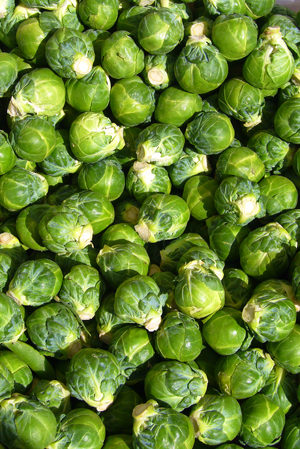A Long Plan for the Short Seasons
Autumn is a wonderful time to be a vegetable gardener in the southwest. It is a time of reflection as we look back joyfully on our successes of the past summer and take note of our failures and how we may improve upon them next year. It is also a time of transition and anticipation of the coming fall planting season as decaying squash and melon vines are soon replaced with the bright greens and deep reds of the fall garden.

Brussels sprout
Photo: Eric Hunt via commons.wikimedia.org
For some of us this transition will be met with feelings of frustration and anxiety when we come to the realization that poor planning has left us with two bad options; either pull out an otherwise productive and healthy plant to make room for cool season crops or delay planting until later in the fall, which will limit the time cool season crops have to establish themselves before their growth slows with the shorter days and cooler temps.
If this sounds familiar, know that you are not alone. Because of the short planting window we have both in the spring and in the fall – and the limited size of most backyard gardens – this is one of the most common situations for new Tucson gardeners. This short planting window makes planning ahead one of the keys to a successful vegetable garden.
To give you an example, I once ordered a variety of Brussels sprouts not realizing the seeds were shipping from Canada. By the time they reached my mailbox almost a month later, the prime planting time was over and I got very little production from an otherwise very productive variety. Had I ordered those seeds well ahead of time, and got them in the ground at the right time, the harvest would have been much larger.
Organic gardeners have long relied on a variety of techniques that can be useful when attempting to plan ahead for the next growing season. One of these techniques, succession planting, involves dividing your garden into separate sections and spacing your plantings out throughout the growing season. By spacing your plantings out in this way, you guarantee that you’ll never have to harvest too much of any one crop at a time and you’ll always have space in your garden for the next season’s crops which means you’ll never have to yank an otherwise healthy plant out of the ground just to make room for new varieties.
Another effective technique that can maximize the use of limited garden space involves the grouping of plants by either different varieties or different maturity dates. The idea is that if you can plant a fast maturing crop in close proximity to a slow maturing crop you can get more production out of the same amount of space. This is a concept known as interplanting and it is very effective at making use of otherwise useless garden space. For example, you can plant radishes in the space surrounding a newly planted cabbage or broccoli plant. The fast maturing radishes will be harvested long before either plant begins to inhibit the growth of the other. In some cases, a second planting of radishes could even be planted before the cabbage reaches maturity.
Much of the success in gardening is often attributed to a nutrient rich soil, or a particular blend of fertilizers. While these factors can play a vital role in the outcome of your garden, proper planning and preparation are just as important if you wish to have a garden that produces high yields year after year. Setting pencil to paper now, long before seeds touch soil, is the best way to ensure that your garden will continue to be productive while also preventing you from having to make a choice between two bad options.
Brandon Merchant is the proprietor of Southwest Victory Gardens. Visit his website at SouthwestVictoryGardens.com.
Category: FOOD & DRINK




